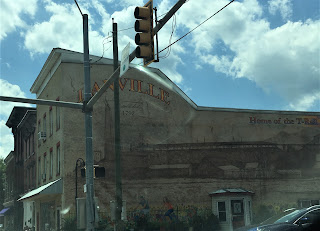It took me longer than usual to finish putting this together, partly because a storm knocked out my internet for a few hours at one point in the week. But it's mostly because we're heading into that time of year where everything happens all at once, especially since I'm in retail, which is why last year I decided to take the month of December off from blogging. I'll be doing that again this year, so look for the annual wrap-up post at the end of the month.
Anyone who's been reading this blog (or any of the other countless sources of information about our commonwealth) for a while knows that Pennsylvania is full of firsts. During my visit to Montour County earlier this year, I encountered this one, which is probably one of the lesser-known firsts, but railroad enthusiasts might be familiar with it.
Railroading in the United States dates back to around 1830, at which time the first locomotives were brought here from Europe. By that point, railroads had been in general use in England's northeast landscape for roughly twenty years. These earliest trains were drawn by horses (hence the use of the term even today of "horsepower"), and then later engines used steam or, more commonly, coal. Railroad tracks, meanwhile, were another story, and they're the focus of this week's quest.
 |
| The marker stands on Northumberland Street (US 11) in front of Danville Middle School |
Stevens devised a form which is known as a T rail. These flanged rails were given the name because they resembled an inverted capital letter T. He also created a hook-headed spike to fasten the T rails to the wooden ties, and rails were connected by what he called an "iron tongue." His first order of T rails arrived in Philadelphia from England in May of 1831 and were placed on their tracks in this manner. Although modern railways use fishplate connectors, and fasten their rails with the use of screw spikes instead of hooked spikes, the T rail became the standard form of rail used across the United States and has remained so ever since.
Of course, ordering the T rails from England was both costly and time-consuming, so there gradually developed a need to manufacture them here in the U.S. It was in Danville that, in 1845, the first iron T rails were rolled at the Montour Iron Works. Whether these were actually the first ones made in the entire country is a subject of some debate, as the community of Mount Savage in Maryland also makes that claim; but Montour's were, if nothing else, the first T rails manufactured in Pennsylvania.
Over the next several years the process was refined and improved; the discovery of several sources of high-quality iron ore in the Great Lakes region during the middle of the 19th century led to the creation of even better quality T rails. More rails were produced at Montour in the 1850s than any other rolling mill in the country. By 1859, the Sunbury and Erie Railroad (later the Philadelphia and Erie Railroad) had finally overcome its various financial difficulties and begun work on its contracted plan to construct a railroad linking the two communities of its original name, and they ordered 30-foot rails from the Montour Iron Works for this purpose.
The industry is also part of the annual Danville Heritage Festival, which used to be called the Iron Heritage Festival, conducted every year on the streets of Danville. Join locals for living history presentations, live music, train rides, fireworks, and other activities to celebrate the spirit of Danville, past and present. Keep an eye on the website for details about next year's event.
Sources and Further Reading:
Except where indicated, all writing and photography on this blog is the intellectual property of Laura Klotz. This blog is written with permission of the Pennsylvania Historical and Museum Commission. I am not employed by the PHMC. All rights reserved.



No comments:
Post a Comment
I would love to hear from you!